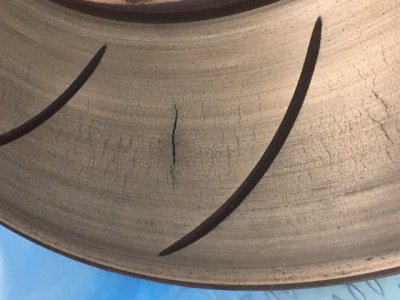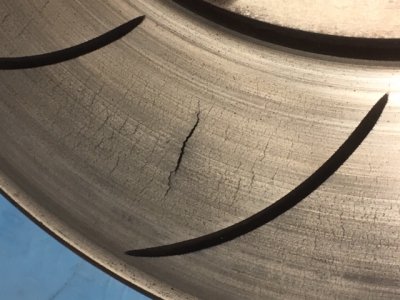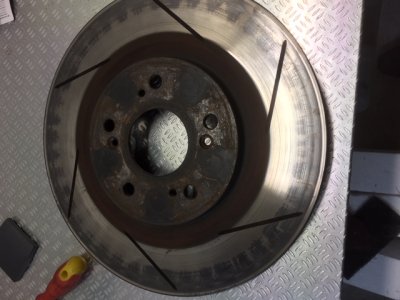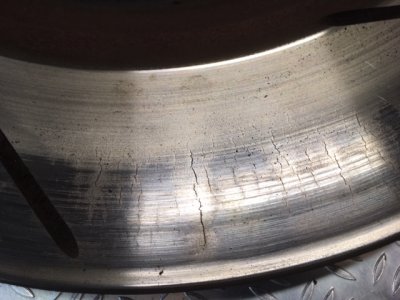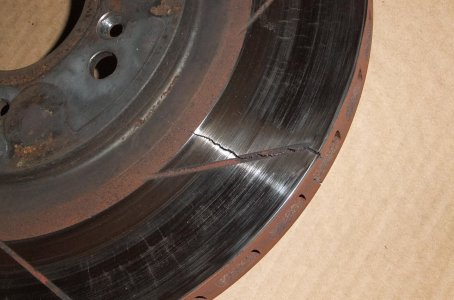-
Protip: Profile posts are public! Use Conversations to message other members privately. Everyone can see the content of a profile post.
You are using an out of date browser. It may not display this or other websites correctly.
You should upgrade or use an alternative browser.
You should upgrade or use an alternative browser.
Billy Johnson and Moto IQ's: Project NSX
- Thread starter FXMDBilly
- Start date
More details about the "Indy" calipers. Brembo themselves informed me a few years back when I visited them to purchase calipers for my F.Atlantic car that the calipers used by Comptech for the NSX were indeed from the rear axle of early 90's Indy cars (for road courses not ovals). Moreover, they were monoblock aluminum calipers machined from billet with some sort of titanium alloy pistons and not cast like most others. Yes they do not have dust caps but are nothing short of amazing especially when abused.
The Quarantine Fifteen (lbs) are sure showing...How are you racers keeping up your skills during the pandemic?
Been following this car on IG, Stunning. Factor X still around? They built some stupid fast NSXs back in the day. Always wanted one!
The Quarantine Fifteen (lbs) are sure showing...
Lol Billy with a pot belly...
Great writeup!! Those PFC calipers look great and very innovative. I can tell you that in my limited Supercars experience, the gallardo 8 piston brakes with 4 brake pads per caliper were not as good brake feel as their Ferrari competitor brakes with 6 piston calipers and 2 pads per caliper. I’m sure the calipers were just not designed as well as the 6 piston ones but I remember people thinking 8 was better than 6 piston lol.
Basically, most of don’t really know what’s best unless someone tells us or we get a lot of experience.
Basically, most of don’t really know what’s best unless someone tells us or we get a lot of experience.
Most are on iRacing. I'm busy developing a dry sump that doesn't take out ACHow are you racers keeping up your skills during the pandemic?
I asked my friends at Brembo Motorsports years ago and followed back up just now regarding these brakes. There is no such thing as an "Indy" caliper. The calipers that Comptech used were the same as the ones they sold, which were 2-piece bolted together. Not monoblock. Comptech did have internal setup sheets that referred to them as Indycar calipers but according to Brembo, there was no Indycar that utilized them.More details about the "Indy" calipers. Brembo themselves informed me a few years back when I visited them to purchase calipers for my F.Atlantic car that the calipers used by Comptech for the NSX were indeed from the rear axle of early 90's Indy cars (for road courses not ovals). Moreover, they were monoblock aluminum calipers machined from billet with some sort of titanium alloy pistons and not cast like most others. Yes they do not have dust caps but are nothing short of amazing especially when abused.
Thanks! Factor X changed to FX Motorsports Development. The group of guys are still around but the team and effort is in hibernation.Been following this car on IG, Stunning. Factor X still around? They built some stupid fast NSXs back in the day. Always wanted one!
Thanks!Great writeup!! Those PFC calipers look great and very innovative. I can tell you that in my limited Supercars experience, the gallardo 8 piston brakes with 4 brake pads per caliper were not as good brake feel as their Ferrari competitor brakes with 6 piston calipers and 2 pads per caliper. I’m sure the calipers were just not designed as well as the 6 piston ones but I remember people thinking 8 was better than 6 piston lol.
Basically, most of don’t really know what’s best unless someone tells us or we get a lot of experience.
That 8-piston, 4-pad caliper is essentially two standard 4-piston calipers in the sense that two pistons act on a single pad like a normal 4-piston caliper. The problem I see in that design is a massive void in the pad area which would struggle to maintain rigidity, especially with a small, removable 2-bolt bridge. StopTech has a huge bridge that uses 4 bolts to increase the rigidity of their calipers. The OEM 8-piston Brembo is unlikely to be as rigid as StopTech's 4 or 6-piston calipers and I bet was a failed engineering exercise hoping that the market would think that "more is better".
The PFC 4-piston caliper has a non-removable bridge, is compact and extremely stiff. That greatly improves pedal feel. 1 pad per piston has better control over 2 pads per piston like in most calipers and that 8-piston Brembo, further improving feel, response, feedback, and modulation. The only OEM caliper off the top of my head that does this is the C6 Z06.
Most interesting article!It's been a few years, but Project NSX is back!
PART 7: Installing PFC Multi-Pad Monobloc Calipers
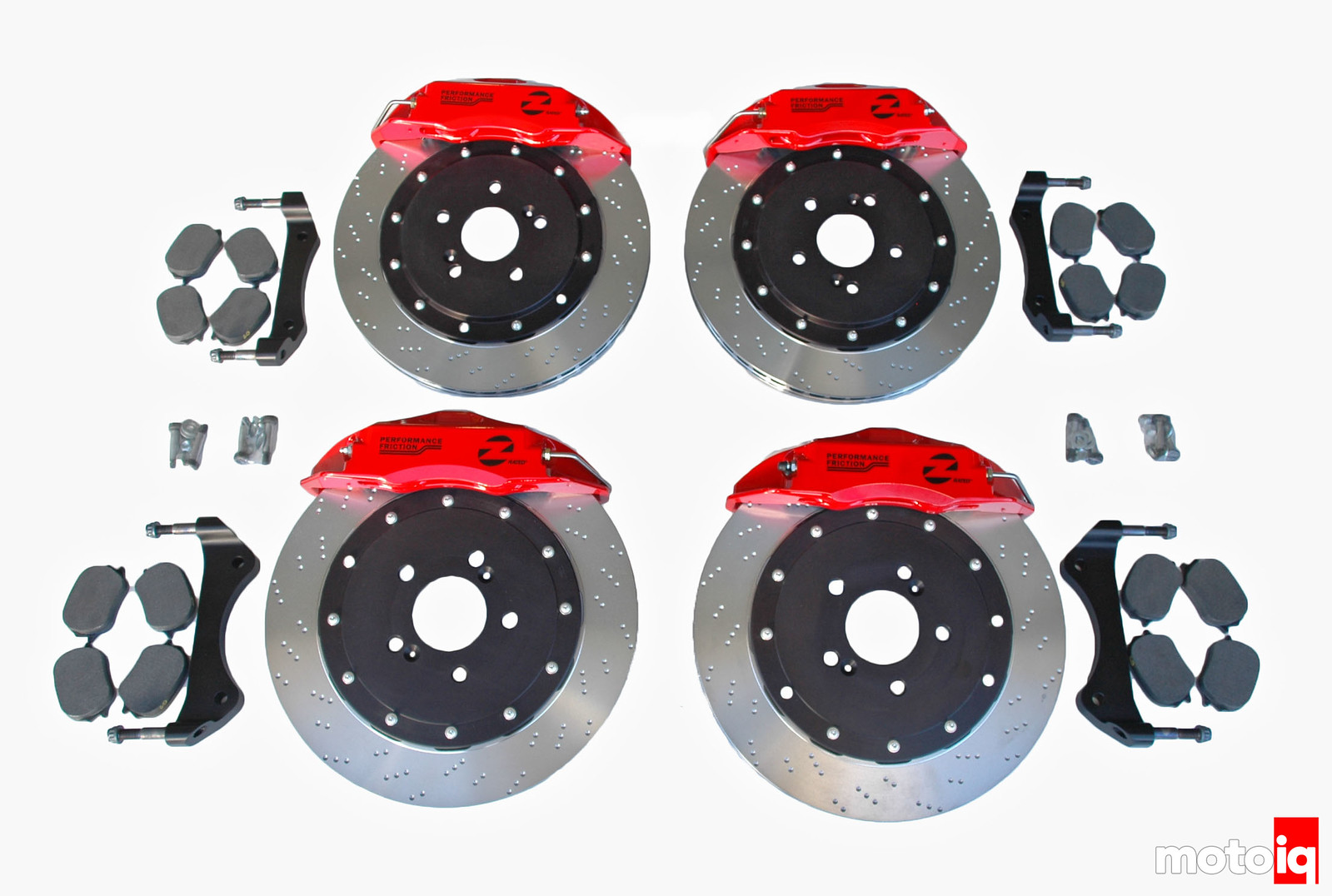
https://motoiq.com/project-nsx-part-7-installing-pfc-multi-pad-monobloc-calipers/
In the article
-History of the Multi-Pad Caliper (4 pads per caliper!)
-Development of the NSX Multi-pad caliper
-Performance Friction Rotor tech
-2000+ ABS update
And much more...
Enjoy!
I believe, I've spent more time on upgrading my brakes on the NSX than on any other modification including the turbo setup...
It all started with a kit from Movit in Germany for the front axle.
They actually used parts from the 993 Turbo with 322X32 disks and Brembo calipers with 38 and 44 mm pistons.
The result was very disappointing as the front wheels would lock up very quickly as the f to r balance was completely off!
As I was trying to restore the 60% front bias, I installed some 4 pot CP 7611 rear calipers on NA2 OEM disks.
These calipers carry 4 each 31.75 mm pistons giving a 62% front bias.
I increased the rear bias a little with higher friction coefficient pads in the rear (PAGID RS 14 rear vs RS 28 in front)
The result is pretty good and I no longer fear running into the back of the GT3's specially since fitting the later ABS system.
The remaining issue however is the disk life for track use that you have not mentionned in your article.
The rear disks will develop dangerous hairline splits that will cause the disk to explode if not taken care off and the front slotted disks now from Brembo go the same way.
Bigger disks like yours would surely be an improvement but at what price???
If you had the stock 91-96 rear brakes and 322 front rotors with 38/44 calipers, you had 67.5% font bias.Most interesting article!
I believe, I've spent more time on upgrading my brakes on the NSX than on any other modification including the turbo setup...
It all started with a kit from Movit in Germany for the front axle.
They actually used parts from the 993 Turbo with 322X32 disks and Brembo calipers with 38 and 44 mm pistons.
The result was very disappointing as the front wheels would lock up very quickly as the f to r balance was completely off!
As I was trying to restore the 60% front bias, I installed some 4 pot CP 7611 rear calipers on NA2 OEM disks.
These calipers carry 4 each 31.75 mm pistons giving a 62% front bias.
I increased the rear bias a little with higher friction coefficient pads in the rear (PAGID RS 14 rear vs RS 28 in front)
The result is pretty good and I no longer fear running into the back of the GT3's specially since fitting the later ABS system.
If you had the stock 97+ rear brakes and 322 front rotors with 38/44 calipers, you had a pretty good 59.5% front bias.
What about disc life are you talking about? Larger diameter rotors will generally run cooler and last longer than a smaller rotor.The remaining issue however is the disk life for track use that you have not mentionned in your article.
The rear disks will develop dangerous hairline splits that will cause the disk to explode if not taken care off and the front slotted disks now from Brembo go the same way.
Bigger disks like yours would surely be an improvement but at what price???
What are you trying to say about rotors developing hairline cracks?
If you had the stock 91-96 rear brakes and 322 front rotors with 38/44 calipers, you had 67.5% font bias.
If you had the stock 97+ rear brakes and 322 front rotors with 38/44 calipers, you had a pretty good 59.5% front bias.
What about disc life are you talking about? Larger diameter rotors will generally run cooler and last longer than a smaller rotor.
What are you trying to say about rotors developing hairline cracks?
I believe you forgot that the rear OEM calipers have only one piston meaning that the pressure on the disks is only half that of a dual opposed piston caliper.
This means that I had 82% front bias with the 38/44 calipers upfront with the OEM rears!
I made this mistake many times BTW...
Here are some pictures of the cracks I was mentionning:
Attachments
Hi John,
Theoretically when calculating Bias, for same piston sizes, floating 2 piston caliper will be the same Bias as fixed 4 piston. The floating mechanism works in a way that when the piston moves to apply force to the disk, the opposite floating part of the caliper will apply the exact same force to the other side of the disk because it is mechanically linked to the piston movement (Like Newton 3rd Low - For every action, there is an equal and opposite reaction, thats why you have pads on both side of the floating caliper and they will last the same), so when calculating Bias to compare a fixed caliper with floating caliper, you use piston area from one side only of the fixed caliper. For example a Spoon Caliper with 36/40 pistons (4 of them) will have the same braking power as OEM 91-96 floating 36/40 pistons (2 of them) because the force that will be applied on the disk depends on the pressure of the brake fluid and area of the pistons from one side (the other side will be opposed by the other two pistons on a fixed or the floating part on a floating caliper). The advantage of fixed caliper is brake modulation and feeling, but it is more expensive to produce than the simpler floating caliper.
The Bias shift you felt is probably more related to the increase on piston area from 36/40 OEM to 38/44 993 Turbo and the bigger disks, further amplified on track by the better fade resistant front setup.
BTW Billy great article! Thanks! Those brakes look great, the only reason I didn't consider them when upgrading was the fact that I didn't want to go 18" wheel upfront.
Theoretically when calculating Bias, for same piston sizes, floating 2 piston caliper will be the same Bias as fixed 4 piston. The floating mechanism works in a way that when the piston moves to apply force to the disk, the opposite floating part of the caliper will apply the exact same force to the other side of the disk because it is mechanically linked to the piston movement (Like Newton 3rd Low - For every action, there is an equal and opposite reaction, thats why you have pads on both side of the floating caliper and they will last the same), so when calculating Bias to compare a fixed caliper with floating caliper, you use piston area from one side only of the fixed caliper. For example a Spoon Caliper with 36/40 pistons (4 of them) will have the same braking power as OEM 91-96 floating 36/40 pistons (2 of them) because the force that will be applied on the disk depends on the pressure of the brake fluid and area of the pistons from one side (the other side will be opposed by the other two pistons on a fixed or the floating part on a floating caliper). The advantage of fixed caliper is brake modulation and feeling, but it is more expensive to produce than the simpler floating caliper.
The Bias shift you felt is probably more related to the increase on piston area from 36/40 OEM to 38/44 993 Turbo and the bigger disks, further amplified on track by the better fade resistant front setup.
I believe you forgot that the rear OEM calipers have only one piston meaning that the pressure on the disks is only half that of a dual opposed piston caliper.
This means that I had 82% front bias with the 38/44 calipers upfront with the OEM rears
BTW Billy great article! Thanks! Those brakes look great, the only reason I didn't consider them when upgrading was the fact that I didn't want to go 18" wheel upfront.
Last edited:
Hi Bruno, I fully understand Newton's laws but what about having the two pistons on the same side of the caliper?Hi John,
Theoretically when calculating Bias, for same piston sizes, floating 2 piston caliper will be the same Bias as fixed 4 piston. The floating mechanism works in a way that when the piston moves to apply force to the disk, the opposite floating part of the caliper will apply the exact same force to the other side of the disk because it is mechanically linked to the piston movement (Like Newton 3rd Low - For every action, there is an equal and opposite reaction, thats why you have pads on both side of the floating caliper and they will last the same), so when calculating Bias to compare a fixed caliper with floating caliper, you use piston area from one side only of the fixed caliper. For example a Spoon Caliper with 36/40 pistons (4 of them) will have the same braking power as OEM 91-96 floating 36/40 pistons (2 of them) because the force that will be applied on the disk depends on the pressure of the brake fluid and area of the pistons from one side (the other side will be opposed by the other two pistons on a fixed or the floating part on a floating caliper). The advantage of fixed caliper is brake modulation and feeling, but it is more expensive to produce than the simpler floating caliper.
The Bias shift you felt is probably more related to the increase on piston area from 36/40 OEM to 38/44 993 Turbo and the bigger disks, further amplified on track by the better fade resistant front setup.
BTW Billy great article! Thanks! Those brakes look great, the only reason I didn't consider them when upgrading was the fact that I didn't want to go 18" wheel upfront.
In this case, it's clear that you have twice as much pressure on the disk.
Moving one piston back to the opposite side produces the same effect.
I believe the confusion comes from the fact that Newton talks about forces and not work.
Even if the pistons hardly move they do travel a little and thus do more work ( distance X force)
No John, is the same, because with fixed caliper you have pistons both sides, but with floating caliper you have pistons one side, and the clamping mechanism the other, and all are working with the pressure on your brake lines, so for the same pressure you will have the same braking power because you add pistons both sides on a fixed caliper but you also have to add pistons with oposite clamp, on the floating caliper, here a pic for you to understand better:
<a data-flickr-embed="true" href="https://www.flickr.com/photos/99522132@N08/49837810281/in/dateposted-public/" title="Floating_VS_Fixed"><img src="https://live.staticflickr.com/65535/49837810281_a308588ba5_c.jpg" width="800" height="305" alt="Floating_VS_Fixed"></a><script async src="//embedr.flickr.com/assets/client-code.js" charset="utf-8"></script>
If the red arrow represents the force that the pad is pressed against the disk, and as long as piston area is the same (Force= pressure x area) you will have the extact same force (each side of the brake disk) in both scenarios, and that is why it is important to properly lubricate caliper slide pins on a floating caliper.
You can see it here:
https://www.tceperformanceproducts.com/bias-calculator/
from that site you have:
"multi piston calipers express their values using one HALF of the caliper body. This accounts for the floating aspect of the single piston caliper. A six pot caliper would be 1.625/1.125/1.125" for example. True clamping force would be double that but also double the single piston of a floating caliper taking into account the 'pull' of the outer pad to the rotor surface. Using total area (all six for example) would require you double that of the floating caliper also- thus the net result is the same whichever way you do it."
<a data-flickr-embed="true" href="https://www.flickr.com/photos/99522132@N08/49837810281/in/dateposted-public/" title="Floating_VS_Fixed"><img src="https://live.staticflickr.com/65535/49837810281_a308588ba5_c.jpg" width="800" height="305" alt="Floating_VS_Fixed"></a><script async src="//embedr.flickr.com/assets/client-code.js" charset="utf-8"></script>
If the red arrow represents the force that the pad is pressed against the disk, and as long as piston area is the same (Force= pressure x area) you will have the extact same force (each side of the brake disk) in both scenarios, and that is why it is important to properly lubricate caliper slide pins on a floating caliper.
You can see it here:
https://www.tceperformanceproducts.com/bias-calculator/
from that site you have:
"multi piston calipers express their values using one HALF of the caliper body. This accounts for the floating aspect of the single piston caliper. A six pot caliper would be 1.625/1.125/1.125" for example. True clamping force would be double that but also double the single piston of a floating caliper taking into account the 'pull' of the outer pad to the rotor surface. Using total area (all six for example) would require you double that of the floating caliper also- thus the net result is the same whichever way you do it."
Hi Bruno, I fully understand Newton's laws but what about having the two pistons on the same side of the caliper?
In this case, it's clear that you have twice as much pressure on the disk.
Moving one piston back to the opposite side produces the same effect.
I believe the confusion comes from the fact that Newton talks about forces and not work.
Even if the pistons hardly move they do travel a little and thus do more work ( distance X force)
Last edited:
I understand all that but if Newton had been in my car when I applied the brakes and locked the front wheels he would have agreed with me.No John, is the same, because with fixed caliper you have pistons both sides, but with floating caliper you have pistons one side, and the clamping mechanism the other, and all are working with the pressure on your brake lines, so for the same pressure you will have the same braking power because you add pistons both sides on a fixed caliper but you also have to add pistons with oposite clamp, on the floating caliper, here a pic for you to understand better:
<a data-flickr-embed="true" href="https://www.flickr.com/photos/99522132@N08/49837810281/in/dateposted-public/" title="Floating_VS_Fixed"><img src="https://live.staticflickr.com/65535/49837810281_a308588ba5_c.jpg" width="800" height="305" alt="Floating_VS_Fixed"></a><script async src="//embedr.flickr.com/assets/client-code.js" charset="utf-8"></script>
If the red arrow represents the force that the pad is pressed against the disk, and as long as piston area is the same (Force= pressure x area) you will have the extact same force (each side of the brake disk) in both scenarios, and that is why it is important to properly lubricate caliper slide pins on a floating caliper.
You can see it here:
https://www.tceperformanceproducts.com/bias-calculator/
from that site you have:
"multi piston calipers express their values using one HALF of the caliper body. This accounts for the floating aspect of the single piston caliper. A six pot caliper would be 1.625/1.125/1.125" for example. True clamping force would be double that but also double the single piston of a floating caliper taking into account the 'pull' of the outer pad to the rotor surface. Using total area (all six for example) would require you double that of the floating caliper also- thus the net result is the same whichever way you do it."
The way to get the real answer is to get the diameter of the pistons on the Stoptech front calipers as they made a real effort to balance the F to R bias with the OEM rear calipers.
Please note that according to your theory my 4 pot rear brakes with 31.75 mm pistons would have further decreased my rear brake bias compared to the OEM 42 mm....
I understand all that but if Newton had been in my car when I applied the brakes and locked the front wheels he would have agreed with me.
Well you went from OEM 36/40mm, 282mm discs to 38/44mm 322mm discs, doing the math would lead to a 35% increased front brake force, so it is natural that you got front lock up.
The way to get the real answer is to get the diameter of the pistons on the Stoptech front calipers as they made a real effort to balance the F to R bias with the OEM rear calipers.
Stoptech pistons are 34/38mm F and 28/28mm R with 330mm brake discs. they have ~62% brake bias to the front.
Please note that according to your theory my 4 pot rear brakes with 31.75 mm pistons would have further decreased my rear brake bias compared to the OEM 42 mm....
No, you have 31,75/31,75mm pistons in the rear against 42,5mm single piston, so if you do 2x(31,75mm piston area) you will see that this is more than 1x(42,5mm piston area). doing the math you will see that 31,75/31,75mm with 300mm would increase rear brake force by ~ 17%
Your setup with 34/38 mm and 322mm disk F and 31,75/31,75mm and 300mm rear will give you ~64% front bias, so having the new ABS you probably have some room to gain braking power by increasing your rear pads aggressivity, witch you are doing already :wink: (have in mind that 97+ NSX and NA2 NSX-R have ~54% front bias)
Upgraded my brakes not long ago to a custom (NA2 NSX-R bias) Stoptech setup, so I needed to to do all the homework :wink::biggrin::biggrin::biggrin:
Last edited:
That is incorrect. It does not matter if you have a 36/40 two piston slider or a 36/40 4-piston caliper. They will have the same bias.I believe you forgot that the rear OEM calipers have only one piston meaning that the pressure on the disks is only half that of a dual opposed piston caliper.
This means that I had 82% front bias with the 38/44 calipers upfront with the OEM rears!
I made this mistake many times BTW...
Also, did you have 91-96 or 97+ rear calipers?
CORRECT.Hi John,
Theoretically when calculating Bias, for same piston sizes, floating 2 piston caliper will be the same Bias as fixed 4 piston. The floating mechanism works in a way that when the piston moves to apply force to the disk, the opposite floating part of the caliper will apply the exact same force to the other side of the disk because it is mechanically linked to the piston movement (Like Newton 3rd Low - For every action, there is an equal and opposite reaction, thats why you have pads on both side of the floating caliper and they will last the same), so when calculating Bias to compare a fixed caliper with floating caliper, you use piston area from one side only of the fixed caliper. For example a Spoon Caliper with 36/40 pistons (4 of them) will have the same braking power as OEM 91-96 floating 36/40 pistons (2 of them) because the force that will be applied on the disk depends on the pressure of the brake fluid and area of the pistons from one side (the other side will be opposed by the other two pistons on a fixed or the floating part on a floating caliper). The advantage of fixed caliper is brake modulation and feeling, but it is more expensive to produce than the simpler floating caliper.
The Bias shift you felt is probably more related to the increase on piston area from 36/40 OEM to 38/44 993 Turbo and the bigger disks, further amplified on track by the better fade resistant front setup.
Thanks! Take another look at the chart on Page 2. Spoon does not have OEM caliper sizes. They use 42.85/38.18 calipers, shifting the bias a little forward on any generation NSX. Also look at Page 6 for a pic of these brakes under 17" CE28s.BTW Billy great article! Thanks! Those brakes look great, the only reason I didn't consider them when upgrading was the fact that I didn't want to go 18" wheel upfront.
I'm quite familiar with rotors cracking from track and racing use. I still don't quite understand your comments on cracking rotors and what I missed in the article.Here are some pictures of the cracks I was mentionning:
Gotta love the new, lighter ABS.
Before:
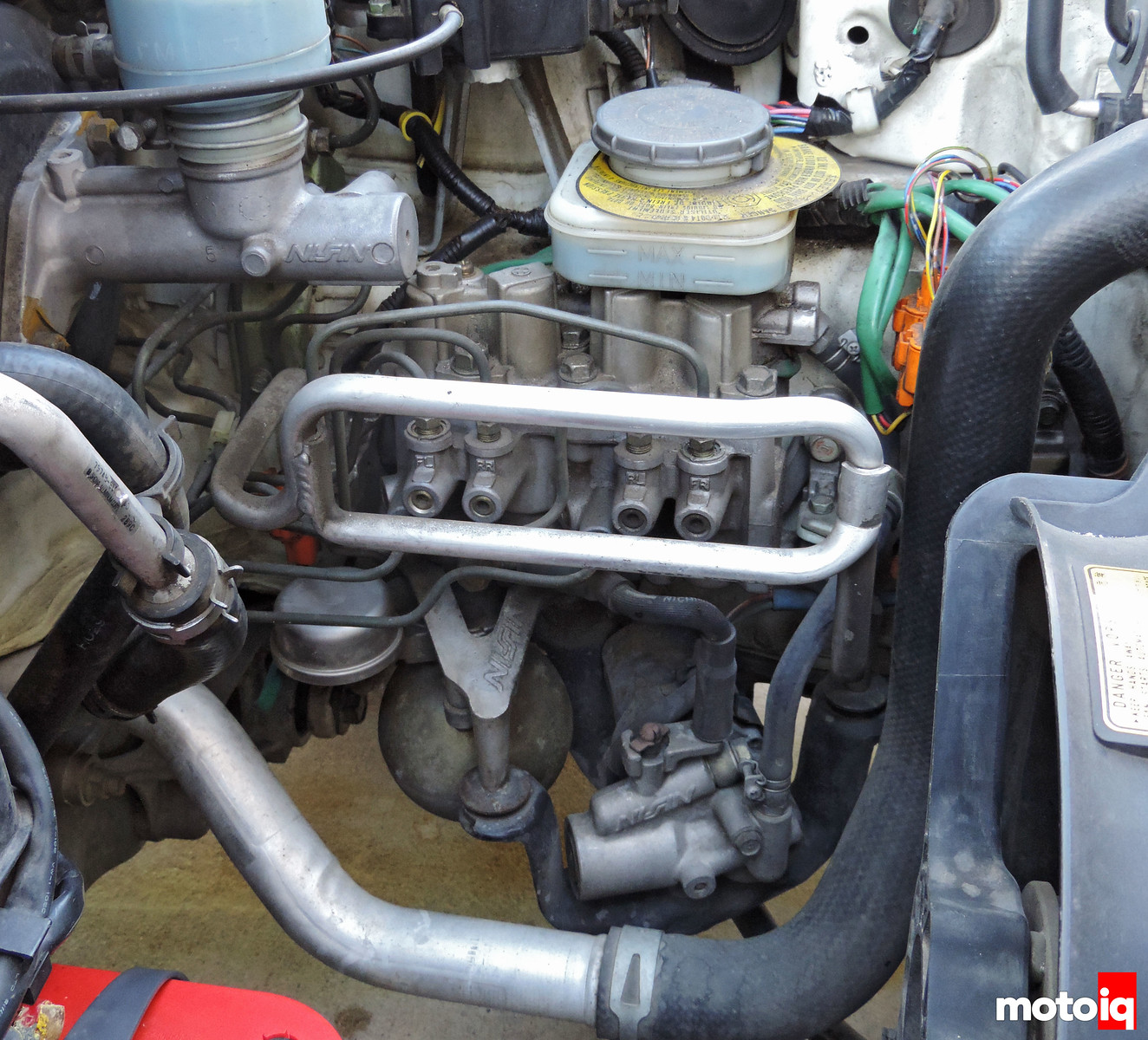
After:
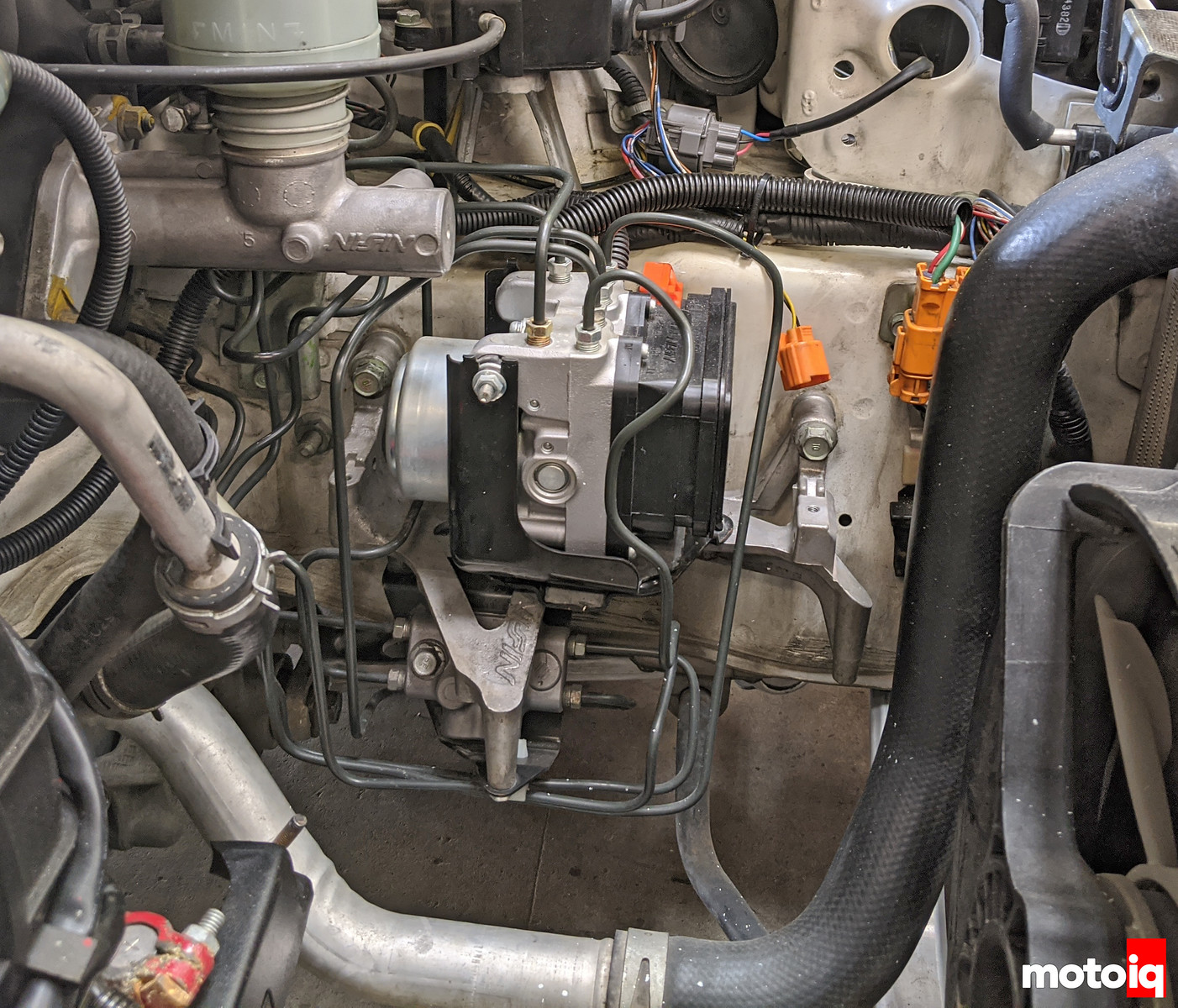
Before:

After:

Well you went from OEM 36/40mm, 282mm discs to 38/44mm 322mm discs, doing the math would lead to a 35% increased front brake force, so it is natural that you got front lock up.
Stoptech pistons are 34/38mm F and 28/28mm R with 330mm brake discs. they have ~62% brake bias to the front.
No, you have 31,75/31,75mm pistons in the rear against 42,5mm single piston, so if you do 2x(31,75mm piston area) you will see that this is more than 1x(42,5mm piston area). doing the math you will see that 31,75/31,75mm with 300mm would increase rear brake force by ~ 17%
Your setup with 34/38 mm and 322mm disk F and 31,75/31,75mm and 300mm rear will give you ~64% front bias, so having the new ABS you probably have some room to gain braking power by increasing your rear pads aggressivity, witch you are doing already :wink: (have in mind that 97+ NSX and NA2 NSX-R have ~54% front bias)
Upgraded my brakes not long ago to a custom (NA2 NSX-R bias) Stoptech setup, so I needed to to do all the homework :wink::biggrin::biggrin::biggrin:
OK Bruno, You win the argument!
I was totally misled by the increased bias with the Movit/Porsche calipers.
BTW did you get Stoptech rear calipers with different size pistons than what they recommend?
That is incorrect. It does not matter if you have a 36/40 two piston slider or a 36/40 4-piston caliper. They will have the same bias.
Also, did you have 91-96 or 97+ rear calipers?
I'm quite familiar with rotors cracking from track and racing use. I still don't quite understand your comments on cracking rotors and what I missed in the article.
OK I'm with you guys on the bias question.
FYI my rear OEM calipers were the 91-96 model.
My comment about cracking the rotors was about cost of ownership.
At one point I replaced my 322X32 Porsche drilled rotors against Brembo slotted curve 328x32 rotors that are more than twice the price but they last less than half as much time...
I'm eager to read your next article on your turbo setup.
In particular, how you will be dealing with the oil cooling on one hand and on the catch can setup on the other?
Keep up the good articles!
Hi John no win here my friend! :biggrin:, just trying to help as I encountered the same problems when doing my homework :wink:
Yes I ended up getting 28/36mm custom setup for the rear (I think it is Audi TT front caliper), with my setup, 34/38mm F and 28/36 Rear I'm at ~55% Bias that is close to my goal (97+ and NA2 NSX-R) as I have NSX-R booster, master cylinder and ABS in my car :wink:
Yes I ended up getting 28/36mm custom setup for the rear (I think it is Audi TT front caliper), with my setup, 34/38mm F and 28/36 Rear I'm at ~55% Bias that is close to my goal (97+ and NA2 NSX-R) as I have NSX-R booster, master cylinder and ABS in my car :wink:
OK Bruno, You win the argument!
I was totally misled by the increased bias with the Movit/Porsche calipers.
BTW did you get Stoptech rear calipers with different size pistons than what they recommend?
Thanks! Take another look at the chart on Page 2. Spoon does not have OEM caliper sizes. They use 42.85/38.18 calipers, shifting the bias a little forward on any generation NSX. Also look at Page 6 for a pic of these brakes under 17" CE28s.
Those CE28s must have incredible clearance...
Keep the great work Billy! and thanks for sharing!
Of course you had lockup issues going to the MovIt front calipers. Your 91-96 bias went from 60.3% to 67.5% !!OK I'm with you guys on the bias question.
FYI my rear OEM calipers were the 91-96 model.
My comment about cracking the rotors was about cost of ownership.
At one point I replaced my 322X32 Porsche drilled rotors against Brembo slotted curve 328x32 rotors that are more than twice the price but they last less than half as much time...
I'm eager to read your next article on your turbo setup.
In particular, how you will be dealing with the oil cooling on one hand and on the catch can setup on the other?
Keep up the good articles!
The turbo coverage wont be for a while. I will be using a Laminova oil cooler and it will be dry sumped, so no catch can.
What size rotors F&R? 13"? If so I got you at 55.6%.Hi John no win here my friend! :biggrin:, just trying to help as I encountered the same problems when doing my homework :wink:
Yes I ended up getting 28/36mm custom setup for the rear (I think it is Audi TT front caliper), with my setup, 34/38mm F and 28/36 Rear I'm at ~55% Bias that is close to my goal (97+ and NA2 NSX-R) as I have NSX-R booster, master cylinder and ABS in my car :wink:
FYI - NSX-R is 53.4%
It depends on the ID of the barrel. Thanks!Those CE28s must have incredible clearance...When I contacted PFC they informed that the brakes wouldnt fit 17...
but probably since I have Prodrive GC-07J and not CE28 I would run in clearance problems...
Keep the great work Billy! and thanks for sharing!
What size rotors F&R? 13"? If so I got you at 55.6%.
FYI - NSX-R is 53.4%
It depends on the ID of the barrel. Thanks!
Yes 13” Billy, after looking at it I decided I was close enough to NSX-R bias! :biggrin:
I will be using a Laminova oil cooler and it will be dry sumped, so no catch can.
!
My question about the catch can was related to the venting required out of the camshaft covers.
Going turbo no longer allows a vacuum to be created to pull in the fumes coming out of the engine.
Beyond that there was a flaw in the design of the rear camshaft cover in the C30 engines allowing oil to stagnate in front of the rear venting outlet.
This was documented by DAL motorsports.
https://web.archive.org/web/20110310192308/http://www.dalmotorsports.com/cars.asp#Sway
As for the oil cooler, it will be interesting to know how many holes you will use in the sandwich plate to balance the flow to the oil cooler without dropping the oil pressure too much.
Similar threads
- Replies
- 50
- Views
- 5K
- Replies
- 34
- Views
- 2K
- Replies
- 6
- Views
- 966
- Replies
- 59
- Views
- 7K
- Replies
- 28
- Views
- 3K








